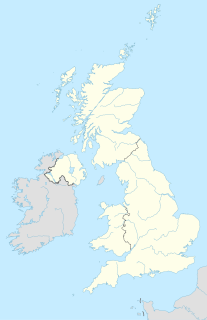
Omagh is the county town of County Tyrone, Northern Ireland. It is situated where the rivers Drumragh and Camowen meet to form the Strule. Northern Ireland's capital city Belfast is 68 miles (109.5 km) to the east of Omagh, and Derry is 34 miles (55 km) to the north.

St Eunan's Cathedral, or the Cathedral of St Eunan and St Columba as it is also known, is a cathedral in the parish of Conwal and Leck, part of the Diocese of Raphoe. Built between the years of 1890 and 1900, the cathedral is found in Letterkenny, County Donegal in Ireland. There are two Catholic cathedrals in the county; an older Catholic cathedral of the same name is found in the town of Raphoe.

Franz Mayer of Munich is a German stained glass design and manufacturing company, based in Munich, Germany, that has been active throughout most of the world for over 170 years. The firm was very popular during the late nineteenth and early twentieth century, and was the principal provider of stained glass to the large Roman Catholic churches that were constructed throughout the world during that period. Franz Mayer of Munich were stained glass artists to the Holy See and consequently were popular with Roman Catholic clients. The family business is nowadays managed in the fifth generation and works in conjunction with renowned artists around the world.

Drumragh Integrated College is an integrated mixed-religion, non-selective secondary school for girls and boys aged from 11 to 18, located at 70 Crevenagh Road, Omagh, County Tyrone, Northern Ireland.

The Diocese of Connor is in the Province of Armagh of the Church of Ireland.
Charitie Lees Smith was an Anglican Irish American hymnwriter. Her hymns, well known in England and Ireland, were included in Lyra Sacra Hibernica, Ryle's Spiritual Songs, Lyra Britannica, and Times of Refreshing. Additionally, she wrote various religious pieces for periodicals.
Drumragh Sarsfields is a Gaelic Athletic Association club based in the village of Clanabogan between Omagh and Dromore in County Tyrone, Northern Ireland. The club was founded in 1972 as a result of an amalgamation of Tattysallagh St. Eugenes and Tattyreagh St.Patricks. Drumragh Sarsfields GAC is a quickly growing Club which has recently completed development of Clubrooms along with two pitches. Phase III of development is currently in progress.
Ballynahatty is a townland in County Down, Northern Ireland. It lies on the southern edge of Belfast. It contains the Giants Ring, a henge monument, consisting of a circular enclosure, 200m in diameter, surrounded with a 4m high earthwork bank with five entrances, and a small neolithic passage grave slightly off-centre. The Giant's Ring is a State Care Historic Monument at grid ref: J3272 6770.

The River Drumragh runs through Omagh, the county town of County Tyrone in Northern Ireland.
McCaul, also spelt MacCawell is an Irish surname, derived from the Gaelic Mac Cathmhaoil, meaning the "son of Cathmhaol", descendant of being implied. The name Cathmhaoil itself is derived from cath mhaol meaning "battle chief". The Mac Cathmhaoil were the leading family of Cenél Fearadhaigh, of the Uí Néill, and were based around Clogher in modern-day County Tyrone, Northern Ireland. They were one of the seven powerful septs that supported the O'Neills. The name is now rare in Ulster as it has been Anglicised under various different forms such as, Campbell, McCawl, Caulfield, McCall, Alwell, Callwell, McCowell, McCuill, Howell, MacHall, and McQuade.

Killyclogher is a village on the outskirts of the town of Omagh, County Tyrone, Northern Ireland. It is also a townland and an electoral ward of Omagh & Fermanagh District Council. According to the 2001 census, it had a population approaching 3000

William Hague Jr. (1836–1899) was a well-known Irish Roman Catholic ecclesiastical architect active throughout mid- to late-nineteenth-century Ireland, particularly in Ulster. He is known as a protégé of A.W.N. Pugin. His office was located at 50 Dawson Street, Dublin.

Omagh East is a barony in County Tyrone, Northern Ireland. It is bordered by nine other baronies: Omagh West and Lurg to the west; Strabane Lower and Strabane Upper to the north; Dungannon Middle and Dungannon Upper to the east; Clogher and Tirkennedy to the south; and Dungannon Lower to the south-east.
Thomas Francis McNamara, RIAI, RIBA, (1867–1947) was an Irish Roman Catholic ecclesiastical architect active throughout the late-nineteenth- to the mid-twentieth-century Ireland who designed many hospitals and Roman Catholic churches. He was a pupil and later managing assistant of William Hague Jr., partner of the architectural firms Hague and McNamara and, later, T. F. McNamara. He was father of architects N.P. McNamara and Charles G. McNamara, who were partners in his firm from the 1920s, the latter absorbed his practice into his own.

Civil parishes are units of territory in the island of Ireland that have their origins in old Gaelic territorial divisions. They were adopted by the Anglo-Norman Lordship of Ireland and then by the Elizabethan Kingdom of Ireland, and were formalised as land divisions at the time of the Plantations of Ireland. They no longer correspond to the boundaries of Roman Catholic or Church of Ireland parishes, which are generally larger. Their use as administrative units was gradually replaced by Poor Law Divisions in the 19th century, although they were not formally abolished. Today they are still sometimes used for legal purposes, such as to locate property in deeds of property registered between 1833 and 1946.
Paul Richard Draper has been Dean of Lismore since 2009.

St. Munchin's Parish is a civil parish that lies partly in County Clare and partly in County Limerick in Ireland, including the center of the city of Limerick. It takes its name from Saint Munchin, the first Bishop of Limerick. According to tradition its church was the first cathedral of the diocese of Limerick, built in 561 AD.












